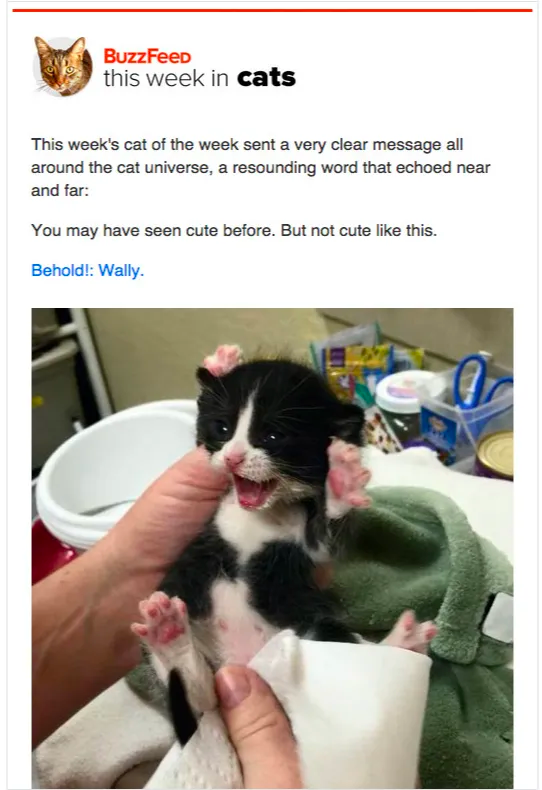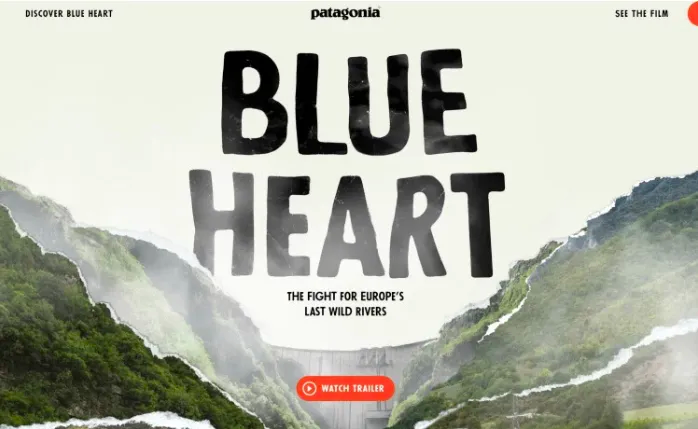Email generates $38 billion in retail sales annually. If you want to get a piece of that pie, you’ll want to maximize your email performance.
One of the best ways is to learn from what has already been proven to work. Specifically, diving into the email marketing strategies of other brands so you can discover what makes them successful.
In this post, we will look at examples of popular email marketing campaigns and point out key takeaways that can be used to inspire your next campaign.
We’ll be looking at email marketing campaign examples from the following five companies to see how they write captivating subject lines, onboard new users, engage their customers and more:
- Uber
- Bonobos
- BuzzFeed
- Headspace
- Patagonia
We’ll also see what makes an effective email campaign: voice, frequency, and simplicity.
Ready? Let’s go.
1. Uber
Uber’s email campaigns are simple and to the point — kind of like their service. Design-wise, the text is usually pretty brief but with a clear CTA which is great for skim readers (more on that later).
For users wanting to learn more, a link to follow is usually easily found somewhere in the email Uber sends subscribers deals and promotions like this one on rates.

This is perfect for subscribers who are quickly skimming the email because “Cheaper Than Ever” really stands out as a CTA and is further emphasized with the “dropping prices by 30%” deal.
And it’s not just limited to promotions. Check out how Uber uses simple but effective copywriting paired with a clean email design to show off new features.

Voice
This email is simple and straight to the point, yet personable and friendly.

Frequency
Again, they keep it simple. A welcome email, promotions, and summaries of your rides are enough to keep users engaged.

Simplicity
A+ on simplicity. Uber limits emails to just one CTA to make it simple for their audience to understand what they need to do.
2. Bonobos
Menswear retailer Bonobos also does a great job of engaging their audience with their emails. How? By giving users a reason to interact.
Emails are clean and minimalistic with a clear CTA that encourages readers to take action.

This email doesn’t have much copy, but what is there is playful — turning what could be a boring product into something you’d want. It’s also perfectly targeted at who would buy this shirt and for what reason (to wear at industry parties).
The structure of this email is pretty clear too. The aim is to target those who don’t want to waste time scrolling through products they don’t want.
How does Bonobos know this? Well, there is a lot going on behind the scenes here.
According to Internet Retailer, they use an algorithm to target consumers who are most likely to buy a particular item.
This data is pulled from previous buyers by color, size, location, how recent the purchase, and other factors. Bonobos then segments these groups so it can target specific audiences with specific products. Nice.
Voice
Bonobos knows its audience (young working professional men) and do a good job of using an appropriate voice injected with humor:

Frequency
One of Bonobos’ biggest strengths with email marketing is knowing when to send emails, whether for new sign-ups who need some help or to re-engage older users.

Simplicity
Bonobos knows how to use whitespace and clear messaging so the next steps after reading one of their emails are clear.
For example, even an abandoned shopping cart email is simple.

Instead of showing the forgotten item like most ecommerce stores, Bonobos keeps it vague to create some curiosity about what was left behind.
3. BuzzFeed
BuzzFeed is the king of subject lines.
Just look at these and tell me you wouldn’t click to read at least a few of them (if not all):

BuzzFeed’s newsletter became one of their top sources of traffic. Why?
Because they write engaging content with equally engaging subject lines, they make you want to click and open that email right away.
The subject lines and preview text are usually short. Often, the preview text answers a question posed in the subject line.
Good copywriting doesn’t end at the subject line either. It continues when you open the email. BuzzFeed is great at sending emails that make their audience engage.

This email gives enough information to pique your interest and makes you want to click through and visit the articles.
This is no accident. Every email BuzzFeed sends is designed to get users to click through to the site and read the full article. It’s for this reason email is one of their strongest growth channels, accounting for 20% of their traffic.
Voice
BuzzFeed segments their lists into people with different interests so they can serve them tailored content all wrapped up in BuzzFeed’s laidback and lighthearted brand voice.

Frequency
What’s great here is the user can choose how many emails they receive by heading over to the subscription page and choosing interests.


While the principle is important, it won’t work for all business models so do what’s right for your audience.
BuzzFeed can get away with sending two emails a day on average because the content is less invasive than a sales email.
People are more likely to read emails like this every day than they are to make a purchase from an ecommerce store. Be sure not to bombard your mailing list.
Simplicity
Of course, BuzzFeed understands simplicity too. You want cats, you got cats.

The important thing here is that BuzzFeed allows users to subscribe based on their interests. They took this a stage further by breaking down topic categories into subcategories (animals >>> cats).
The takeaway here is segmenting subscribers and serving them content they are interested in reading.
4. Headspace
Headspace is an app for guided meditation.
What sets their emails apart is the design. They feature playful characters and beautiful relaxing colors.
Using this welcome in their onboarding emails is a masterstroke.

Their email does lots of things well, but to pick out a few:
- It sets a clear goal – it’s obvious what a new user is expected to do here — start meditating.
- It focuses on benefits – Headspace makes the email about the benefits their app will give users — a happier and healthier life.
- It’s fun – the soft colors and quirky character designs help to create positive customer emotions about the app.
Why bother with onboarding emails?
Effective onboarding leads to higher retention rates, higher revenues, and an increase in customer lifetime value.
Voice
Headspace is skilled at aligning their voice with what they offer.
Frequency
A gentle number of emails to calm onboarding new users and provide useful little reminders for existing ones. According to Mailcharts, this works out at roughly 14 per year.
Simplicity
An example of simplicity at its finest.

Not only is this a simple email, but it is also in keeping with Headspace’s core offering to simplify your life through guided meditation.
5. Patagonia
Outdoor clothing retailer Patagonia sends a variety of emails featuring blog posts, interviews, promotions as well as information on social issues they are raising awareness for.
Sending a mixture of content gives users a reason to open their emails, even if they don’t want to buy something.
Patagonia maximizes engagement with a mix of eye-catching email content.

This email is very easy to read and clearly lays out the products on offer.
On the flip side, the next email isn’t trying to sell any Patagonia products. Its purpose is to raise awareness and grab your attention.

Voice
Patagonia has really honed in on a simple and lighthearted voice to gently push their audience into buying products.

Frequency
Not only does Patagonia send emails every couple of days, but they also send them at personalized times, tailored to when individual users are more likely to read, click, and interact with them.
Simplicity
Although there may be a lot going on in some Patagonia emails, they are always easy to read.

Instead of following a more standard promotional product email, this image lets the product do the talking with some supporting copy to highlight durability.
Successful Email Marketing Campaign Takeaways
When it comes to a successful email marketing campaign, there is no one thing needed in order to stand out. However, there are a few common elements found in the best emails.
Voice
All of the email marketing examples have a well-established brand voice. This unique voice helps them stand out and is carried across all communication channels, not just email.
Users and readers of the emails benefit from a more personalized, friendly approach which in turn, creates a stronger sense of brand loyalty as customers feel less like numbers on a list and more like people.
Frequency
It doesn’t matter if it’s daily or weekly, having an email schedule that works for your customers is key.
All of the best email marketing campaigns listed had a clearly defined schedule, whether for updates, promotions, or onboarding emails.
You should do the same for your email subscribers.
Simplicity
Simplicity refers to both writing style and email design. Both are equally important.
Writing-wise, you want to use simple and commonly shared language (for your user audience). Design-wise, less is more. Whitespace and small banner images go a long way.
The aim of both writing and design is to make it as easy as possible for your audience to digest your email.
Wrapping Up
These are just a few of our favorite email marketing campaign examples.
Every day our inboxes are flooded with newsletters and promotional emails. The best thing we can do is follow the best practices in these examples and put them to use for your business.
Re: How Nexcess Can Help
Success takes work. You're thinking about your target demographics, developing email marketing strategies, sourcing inventory, and other fundamental parts of running an ecommerce business.
Nexcess Managed Hosting plans are more than just a place for your site to "live." With automatic updates, smart monitoring, tools and features that supercharge your ecommerce site – hosting your site on Nexcess goes beyond expectations.
Expect more from your host. Check out our plans to get started today.

